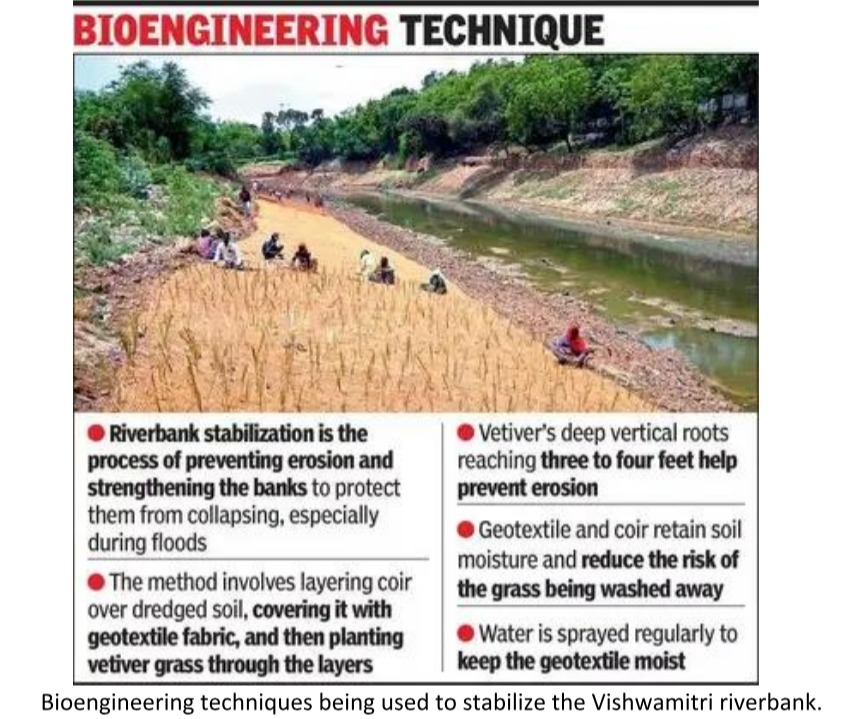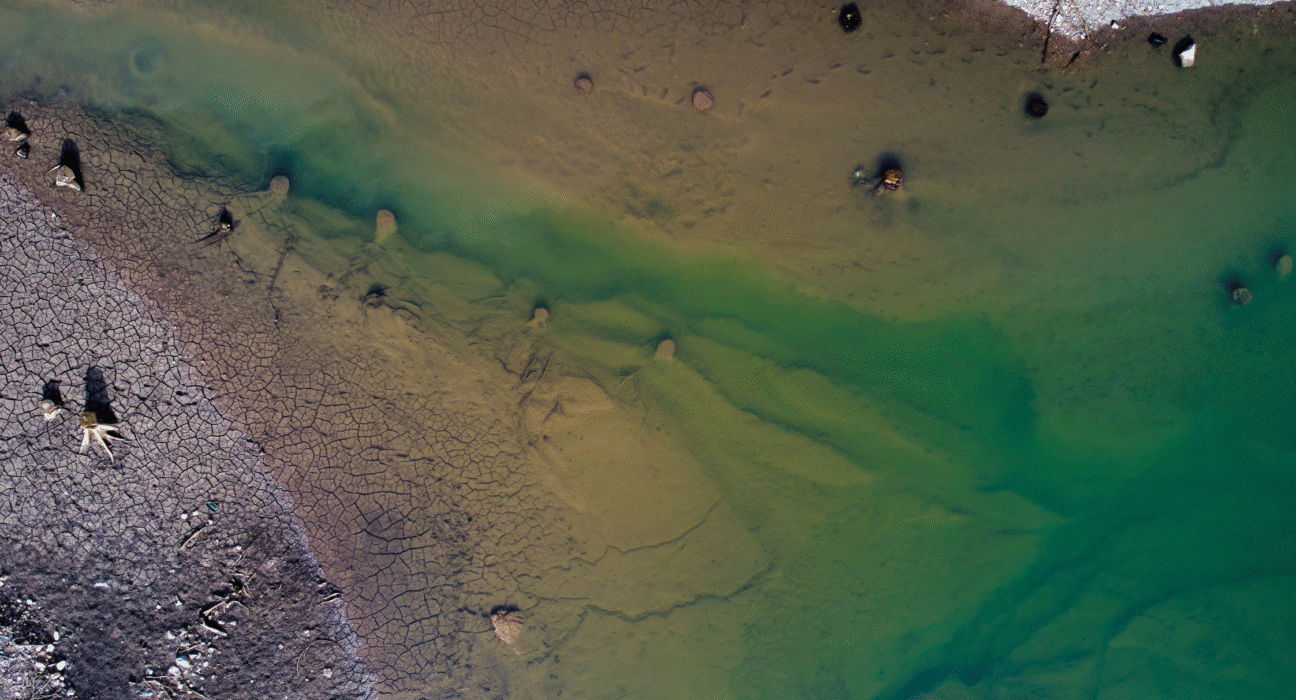By: Mehak, Former MRC Intern from St. Stephen’s College, DU (Supported by Romit Kaware, MRC Research Fellow)
India’s vast and ecologically varied river network presents incredibly complex sediment
management challengesUnderwater Domain Awareness (UDA) provides a transformative framework for sediment management in India.
The Vishwamitri case should act as a turning point by catalyzing a shift toward data driven and system wide river management across India
- Moving towards an integrated, adaptive, and collaborative approach to sediment management is essential to protect India’s vital river systems.
The Vishwamitri River in Vadodara, Gujarat, recently experienced unexpected and significant erosion after a large-scale dredging and desilting project. This incident serves as a crucial reminder that before undertaking major river engineering work, it is absolutely vital to thoroughly understand how the river’s natural sediment (Like sand, silt, and gravel) moves and settles. The erosion occurred even in areas where efforts were made to stabilize the banks, highlighting the dangers of not fully grasping a river’s natural behavior and the need for a more comprehensive and science-driven approach to river management and flood control.
Happenings at the Vishwamitri River-
After the dredging operations concluded, parts of the Vishwamitri River’s banks, which had never eroded before, began to show signs of damage. The Vadodara Municipal Corporation (VMC) had initiated a massive project to remove over 1.5 million cubic meters of silt from the river. The goal was to increase the river’s flow capacity and reduce the risk of flooding in the city of Vadodara. However, the monsoon season arrived shortly after the dredging, limiting the effectiveness of stabilization measures like planting vetiver grass and using coir geotextiles (Natural fabric mats). As a result, erosion was observed even where these bioengineering techniques were applied thereby raising serious questions about their effectiveness and the overall strategy for managing the riverbanks.

An expert committee overseeing the project also noted that the construction of new expressways and bullet trains was obstructing the river’s natural water flow. They highlighted that the interventions were mostly focused only on the riverbanks, completely overlooking the broader floodplain and the complex ways sediment moves within it. The removal of natural vegetation along the banks, combined with the failure to clear debris and address illegal encroachments, further increased the risk of erosion and harmed the river’s natural balance. The Vishwamitri River’s sediment movement is naturally influenced by monsoon rains, urban development, large infrastructure projects, and how the land has been used historically. The recent dredging, while intended to help with floods, didn’t fully consider these local complexities. This led to rapid erosion in some areas, clearly showing that a ‘One size fits all’ approach doesn’t work as river interventions must be specifically tailored to each river’s unique characteristics.
Importance of Sediment Transport Studies
Sediment transport involves the movement of sand, silt, and other particles by water and is a fundamental process that shapes a river. It directly affects the riverbed’s depth, the stability of its banks, the health of aquatic life, and how well flood control measures actually work. When sediment is removed through dredging without a complete understanding of how it naturally moves and settles in that specific area, the river’s delicate balance is disrupted. This can lead to unexpected and accelerated erosion in some places, while causing excessive buildup of sediment in others. Such imbalances harm both the river’s ecosystem and human-built infrastructure.
Sediment transport studies are vital tools for river management. They allow experts to predict how a river will react to human interventions like dredging, dam construction or changes to it’s banks. These studies provide crucial insights into where sediment will go by identifying areas likely to erode or accumulate and assessing the potential impact on buildings, bridges and natural habitats. Without reliable data from these studies, efforts to stabilize riverbanks can be ineffective or even make things worse as the Vishwamitri River case clearly demonstrated. Such detailed analyses help guide the correct application of mitigation measures, whether it’s using natural bioengineering techniques or building structures like gabion walls (Mesh cages filled with rocks).
The way sediment flows is a dynamic process that is influenced by factors such as the amount of water flowing in the river, the supply of new sediment, changes in land use around the river, and variations in climate. Therefore, long-term monitoring and advanced computer modeling are essential. This ensures that river management can adapt to changing conditions and prevent negative outcomes such as rivers running dry downstream due to a lack of sediment or excessive buildup upstream.
The Role of Underwater Domain Awareness (UDA) in Sediment Management-
Effective and long-term sediment management needs to move beyond quick fixes like routine dredging. While dredging can temporarily increase a river’s capacity and reduce flood risks, it often has unintended negative consequences downstream, including bank erosion, loss of natural habitats, and disruption of the sediment supply that healthy rivers need. Sustainable sediment management requires a holistic and basin-wide approach that considers everything, such as how rivers behave upstream and downstream, land use patterns, and the combined effects of multiple human interventions. Nature- based solutions like replanting vegetation, restoring wetlands, and allowing controlled reconnection with floodplains offer promising alternatives for managing sediment flow more naturally.
This holistic perspective is critical for accurately predicting sediment flow, which in turn enhances the ability to withstand emerging threats like climate change and rapid urbanization.
UDA can also significantly aid in building national capacity and capability for sediment management. By creating strong partnerships between users (Like municipal corporations), academic institutions (For research and expertise), and industry (For technology and solutions), UDA can enhance technical competency and help mobilize necessary resources. This collaboration can lead to the creation of clear policies and standardized procedures, promoting best practices across India’s diverse river systems. Furthermore, the deployment of real-time monitoring tools, often part of UDA systems, will provide early warnings of sediment related hazards, allowing for timely interventions.
India’s vast and ecologically varied river network presents incredibly complex sediment management challenges. Unique conditions such as intense monsoonal variability, rapid urbanization, and socioeconomic disparities mean that generic solutions won’t work and region-specific interventions are essential. Addressing these challenges requires strong government support, including investment in professional training, establishing dedicated research and monitoring centers, and developing clear national sediment management guidelines.
Equally important is the role of community engagement and collaboration across different sectors. Actively involving local communities in monitoring efforts enhances the practical relevance of sediment interventions. Such a ‘Bottom up’ approach allows a sense of ownership and shared responsibility for maintaining river health, thereby increasing the long-term success of management strategies.
Conclusion
The recent erosion events observed along the Vishwamitri River serve as a stark reminder and underscore the urgent need for scientifically informed and region-specific sediment management approaches. Effective and sustainable interventions necessitate a comprehensive understanding of sediment dynamics, long term planning, and the crucial incorporation of Underwater Domain Awareness. Moving towards an integrated, adaptive, and collaborative approach to sediment management is essential to protect India’s vital river systems, critical infrastructure, and vulnerable communities from the escalating risks of erosion, excessive sedimentation, and ecological degradation. The Vishwamitri case should therefore act as a turning point by catalyzing a shift toward data-driven and system-wide river management across India.
References

Mehak
About Author
Mehak interned with the Maritime Research Center, contributing to its outreach initiatives, including the UDA Journal and the UDA Knowledge Center. She is currently pursuing English Literature at St. Stephen’s College, University of Delhi.


